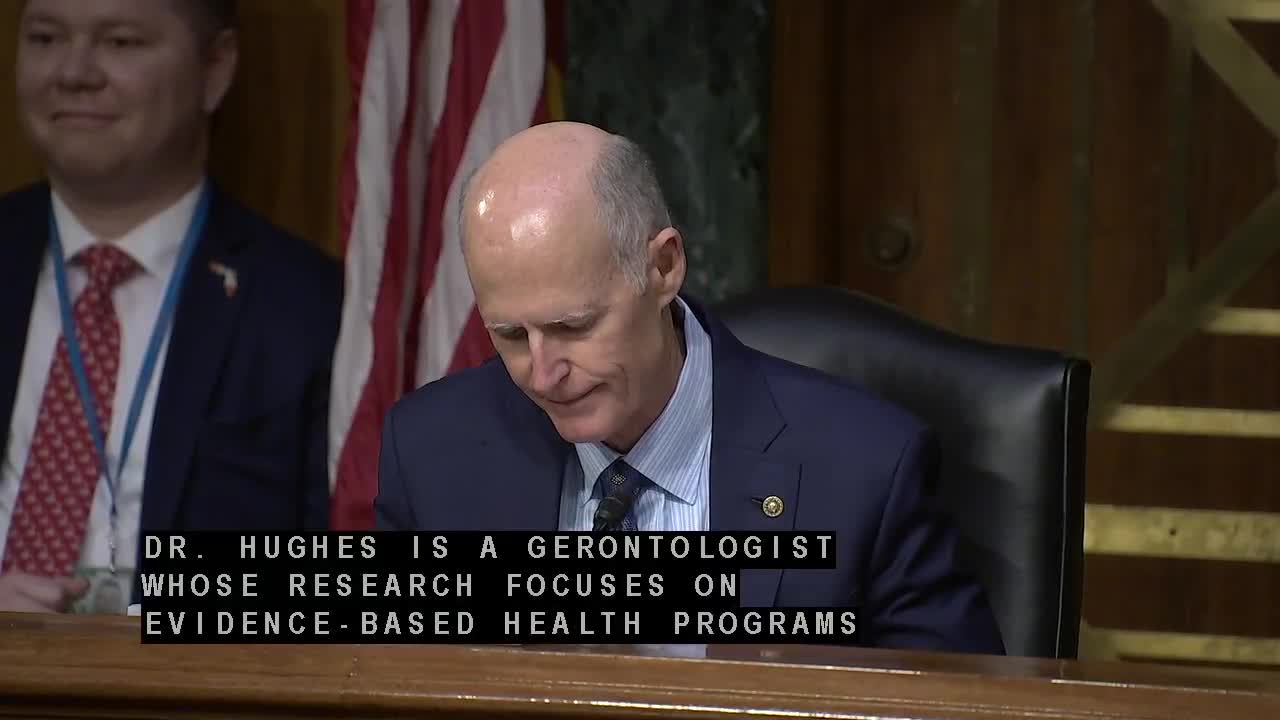Witnesses urge Congress to expand evidence‑based wellness programs for older Americans
January 15, 2025 | Aging (Special), Special, Select and Other Committees - House & Senate, Congressional Hearings Compilation
This article was created by AI summarizing key points discussed. AI makes mistakes, so for full details and context, please refer to the video of the full meeting. Please report any errors so we can fix them. Report an error »

Dr. Susan Hughes, director of the Center for Research on Health and Aging at the University of Illinois Chicago, told the Senate Special Committee on Aging that evidence‑based health promotion programs reduce disability and can produce large returns if scaled.
Hughes said, "Fit and Strong costs $300 per participant. It has no harmful side effects and large effect sizes." She described the program’s eight‑week curriculum (flexibility, aerobics, systematic lower‑extremity strength training and group problem solving) and said trial participants sustained gains at 18 months, including improved joint pain, strength and mobility.
Hughes urged Congress to reauthorize the Older Americans Act, increase funding for Title III‑D (the program that supports certain evidence‑based health promotion activities) and consider a new funding set‑aside for physical‑activity programs. She said current distribution depends heavily on Title III‑D funds and that "these funds are critical but insufficient to meet growing demand."
Dr. Don Carr, director of the Claude Pepper Center at Florida State University, recommended shifting U.S. aging policy to a life‑course framework that emphasizes prevention and earlier intervention. "Health problems in later life are strongly influenced by events, exposures, and behaviors that occur well before we reach our later years," Carr said, and argued for more mid‑life interventions, retraining and opportunities for phased retirement to support health and employment.
Both witnesses noted barriers to scaling: limited funding flows, lack of reimbursement or incentives for Medicare Advantage plans to adopt wellness programs, and no standardized national distribution pipeline for evidence‑based interventions. Hughes recommended a partnership among the National Institute on Aging, CDC, the Administration for Community Living and CMS to accelerate dissemination.
Members asked about measurable returns and program scalability. Hughes pointed to hypothetical models showing reductions in costly procedures (for example, joint replacements) if physical‑activity programs reduce progression to surgical need and said some public‑health grants have supported state‑level dissemination of Fit and Strong.
Clarifying note: witnesses cited current Title III‑D funding in the hearing record using inconsistent numeric formatting; the written testimony provided to the committee contains detailed funding and program lists (witnesses said they submitted a full list to the record).
Hughes said, "Fit and Strong costs $300 per participant. It has no harmful side effects and large effect sizes." She described the program’s eight‑week curriculum (flexibility, aerobics, systematic lower‑extremity strength training and group problem solving) and said trial participants sustained gains at 18 months, including improved joint pain, strength and mobility.
Hughes urged Congress to reauthorize the Older Americans Act, increase funding for Title III‑D (the program that supports certain evidence‑based health promotion activities) and consider a new funding set‑aside for physical‑activity programs. She said current distribution depends heavily on Title III‑D funds and that "these funds are critical but insufficient to meet growing demand."
Dr. Don Carr, director of the Claude Pepper Center at Florida State University, recommended shifting U.S. aging policy to a life‑course framework that emphasizes prevention and earlier intervention. "Health problems in later life are strongly influenced by events, exposures, and behaviors that occur well before we reach our later years," Carr said, and argued for more mid‑life interventions, retraining and opportunities for phased retirement to support health and employment.
Both witnesses noted barriers to scaling: limited funding flows, lack of reimbursement or incentives for Medicare Advantage plans to adopt wellness programs, and no standardized national distribution pipeline for evidence‑based interventions. Hughes recommended a partnership among the National Institute on Aging, CDC, the Administration for Community Living and CMS to accelerate dissemination.
Members asked about measurable returns and program scalability. Hughes pointed to hypothetical models showing reductions in costly procedures (for example, joint replacements) if physical‑activity programs reduce progression to surgical need and said some public‑health grants have supported state‑level dissemination of Fit and Strong.
Clarifying note: witnesses cited current Title III‑D funding in the hearing record using inconsistent numeric formatting; the written testimony provided to the committee contains detailed funding and program lists (witnesses said they submitted a full list to the record).
View full meeting
This article is based on a recent meeting—watch the full video and explore the complete transcript for deeper insights into the discussion.
View full meeting